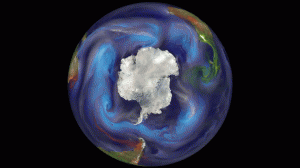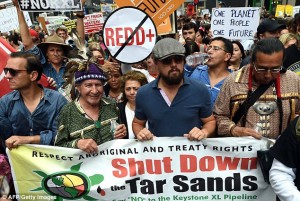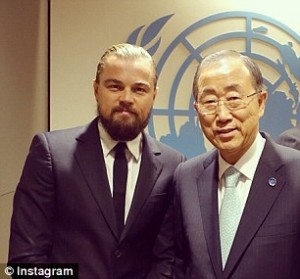 I have had the incredible opportunity to not only participate in this mosaic, but also to join in the single largest climate change related demonstration ever. While I would have marched in The People’s Climate March in New York City on September 21st regardless of what I am studying now, it does help that I am spending my entire semester studying climate change and have been throwing myself into the world of international negotiations (which this march was aimed at). It is nice for a change to see the other major side to the climate change movement. Near the end of the march, there was no movement though. The people were stuck. The UN had been blocked off by the the immense swath of marchers. This was not a bad thing though, there were simply so many people taking part, that the streets were completely saturated.. There were so many that the organizers had to start diverting marchers from the established pathway because it was becoming difficult for anyone trying to leave the march needing to get out of the streets. This is what is needed though. This meeting of the people and the leaders of the world is necessary. In order to start making serious progress on climate change mitigation and adaptation pressure needs to be applied on world governments. This issue needs to be at the forefront of their minds, as often a possible. It is this demonstration that will hopefully do that. Imagine a world without these types of demonstrations. Where would the great global society be now? How far behind would we be? The march wasn’t just about reducing carbon emissions and trying to get the world’s leaders to get along with one another, it encompassed so much more. There were groups from every walk of life. From Al Gore’s Climate Reality to groups of anarchists. This march wasn’t s single event either. It was held all over the world. There were over 2,600 events in 150 countries, with the main march being in NYC where alone somewhere between 300,000 and 400,000 people participated. Even UN Secretary-General Ban Ki-moon joined in the march. More of my photos here.
I have had the incredible opportunity to not only participate in this mosaic, but also to join in the single largest climate change related demonstration ever. While I would have marched in The People’s Climate March in New York City on September 21st regardless of what I am studying now, it does help that I am spending my entire semester studying climate change and have been throwing myself into the world of international negotiations (which this march was aimed at). It is nice for a change to see the other major side to the climate change movement. Near the end of the march, there was no movement though. The people were stuck. The UN had been blocked off by the the immense swath of marchers. This was not a bad thing though, there were simply so many people taking part, that the streets were completely saturated.. There were so many that the organizers had to start diverting marchers from the established pathway because it was becoming difficult for anyone trying to leave the march needing to get out of the streets. This is what is needed though. This meeting of the people and the leaders of the world is necessary. In order to start making serious progress on climate change mitigation and adaptation pressure needs to be applied on world governments. This issue needs to be at the forefront of their minds, as often a possible. It is this demonstration that will hopefully do that. Imagine a world without these types of demonstrations. Where would the great global society be now? How far behind would we be? The march wasn’t just about reducing carbon emissions and trying to get the world’s leaders to get along with one another, it encompassed so much more. There were groups from every walk of life. From Al Gore’s Climate Reality to groups of anarchists. This march wasn’t s single event either. It was held all over the world. There were over 2,600 events in 150 countries, with the main march being in NYC where alone somewhere between 300,000 and 400,000 people participated. Even UN Secretary-General Ban Ki-moon joined in the march. More of my photos here.
From A Different Angle: The Photography of Sebastião Salgado
Earlier this week, famed nature photographer and documentarian James Balog was on Dickinson’s campus for a two-day residency as part of the Rose-Walters Prize he received at Commencement this past May. His vivid pictures and time-lapse videos of glacial retreat are a stark representation of the scope and rate of global warming and climate change in our own lifetime. While Balog approached his photography as an avenue for showing the beautiful destruction of the climate, Brazilian photographer Sebastião Salgado’s most recent work, Genesis, shows the inherent beauty of the world that is at peril of being disturbed or lost forever to the effects of climate change. Deserts, ice, endangered species, beautiful designs naturally cut along a valley are a few of the subjects of Salgado’s photographs. His work approaches the same vein as Balog’s, just from a different angle, and both angles have a story that is important for everyone to experience and internalize as we approach the climate question. The Earth around us is a beautiful, one-of-a-kind environment that is imperative for us to cherish and protect from ourselves so that future generations may have the privilege and honor to cherish and protect it as well. As we move forward in our work this semester at COP20 and in all future climate negotiations, it is crucial that this message not be lost upon us.
James Balog at Dickinson College
By Elizabeth Plascencia

I was a senior in high school when I first watched Chasing Ice. Nearly three and a half years later I had the honor of introducing Mr. James Balog for his public lecture at Dickinson College. Combining visual arts and science, Balog has presented the retreating ice of the world as a force to be reckoned with. Combating climate change skeptics with multi-year record proof, Balog is somewhat of a hero to me. Mindfully capturing these beautifully dynamic and fragile masses, he told a story.
In lieu of the Lorax – Mr. Balog speaks for the ice.


Balog’s residency granted me the opportunity to interact through open class discussions and an afternoon student luncheon. Overall this experience has propelled me into the pursuit of finding my voice.
What will my cause be to champion? I speak for change.

[youtube_sc url=”https://www.youtube.com/watch?v=eIZTMVNBjc4″ title=”Chasing%20Ice%20Official%20Trailer%20″]
The Solution in Livestock
Meat production is a well know contributing factor to climate change. Livestock is a major source of worldwide greenhouse gas emissions, as well as a large factor behind deforestation. Many have argued that a necessary step in mitigating climate change is a change in diet to eat less meat (O’Callahahan). However, Allen Savory offers a comprehensive solution to climate change by doing just the opposite. In his research, he has found that it is possible to safely sequester large amounts of carbon, and reverse desertification though the use of livestock. The approach is a plan to mimic nature through what he calls “holistic planned grazing.” The livestock (usually cattle) are bunched tightly together to till and fertilize the soil, turning the dry land into productive grasslands (Savory).
Each acre of land is able to sequester one ton of carbon per year through the increased bio-productivity, and there are 12 billion acres of land worldwide available for holistic planned grazing (Sacks).That means that it is possible to sequester 12 billion tons of carbon each year (the equivalent of 6ppm) (Sacks). According to his calculations this process has the potential to return the atmosphere to pre-industrial levels (280ppm) within thirty years (Sacks). That rapid of a change is astounding.
The process of all nations reducing their emissions enough to make an impact on climate change will be a slow one, even if aggressive action is taken. The possibility of this radicle mitigation approach through livestock is incredibly astounding and hopeful to me.
You can watch his ted talk below:
[youtube_sc url=”https://www.youtube.com/watch?v=vpTHi7O66pI” title=”ow%20to%20fight%20desertification%20and%20reverse%20climate%20change”]
Work Cited:
O’Callahahan ,Jonathan. “Eating meat is causing ‘dangerous climate change’, claim scientists.” Mail Online. Associated Newspapers, 1 Sept. 2014. Web. 24 Sept. 2014. http://www.dailymail.co.uk/sciencetech/article-2739143/Less-meat-key-food-security.html
Sacks, Adam D.. “The Fight Against Global Warming: A Failure and A Fix.” Savory Institute . N.p., n.d. Web. 24 Sept. 2014. <http://swelterdesigns.com/climate_articles/the%20fight%20against%20global%20warming%20-%20a%20failure%20and%20a%20fix%20r13%20-%20short.pdf>.
Savory, Allan . “How to fight desertification and reverses climate change.” TED2013. TED. Sustain!, Long Beach. 27 Feb. 2013. Speech.
Green Devil Interview!
The Green Devil of Dickinson College was interviewed about climate change today! Check out what he had to say!
Actors pretend for a living, the rest of the population does not.
Tuesday morning actor Leonardo DiCaprio addressed world leaders at the UN Climate Summit. What was this product of hollywood doing in a room full of heads of states? Well, he compared his acting career of “pretending for a living” and “solving fictitious problems” to how humankind is confronting climate change, pretending it is not happening to our planet. I’m sure many of us has seen hollywood “climate-fiction” films such as The Day After Tomorrow, but we must be able to differentiate fact from hollywood’s fiction. Is getting the fictitious world of hollywood involved in the fight against climate change an effective wake up call? How do we get the people to stop pretending and face reality?
Read DiCaprio’s full speech here
Climate Modeling: The Completion of the Climate Jigsaw Puzzle

Helen Walters of TED had some questions that were worth asking. The main question she asked was “How do you solve a problem like the climate crisis?” However, the real question is how does one truly understand the earth’s climate when there is just more than a few factors involved?
Well, according to climate scientist Gavin Schmidt, climate modeling is “The discipline that synthesizes data from multiple sources, including satellites, weather stations, even from people camping in the Arctic and submitting measurements of the ice they see around them.” Basically, it is the consolidation of data from all over that helps us understand what goes on. It helps us see the big picture. He provided us with four silent animations that show what is really going on with our climate. The links are listed below.
Cloud patterns over North America
Watch particles swirl in the atmosphere
Real vs. prediction: Watch the world’s climate change throughout the 20th century
3 ways the climate might look in the future
I really liked the analogy of looking at the climate as a jigsaw puzzle that needs to be completed. That was very clever! You need all the puzzle pieces to complete it just like we need to know all the factors involved in the climate to fully understand it. Without the big picture, it is harder to put the puzzle pieces together.
The 411 On the UN Climate Summit
UN Climate Summit- Catalyzing Action video
Up to 400,000 people joined my classmates in New York on Sunday and millions more from around the world marched as well for action to address climate change. This global march addressing global climate change kicked-off “Climate Week- NYC” based around the Tuesday September 23rd UN Climate Summit, called by Secretary-General Ban Ki Moon.
Ban Ki Moon called this summit on September 2, 2014, calling on a variety of leaders to come together to take more definitive actions against climate change. The UN Climate Summit is separate from the UNFCCC and thus separate from COP politics. Ban Ki Moon quoted his frustration with climate action lacking ambition thus far pushing his goal for this summit  bring more ambitious climate work to life.
bring more ambitious climate work to life.
Specifically there are two goals of the Climate Summit. One, “to mobilize political will for a meaningful universal agreement at the climate negotiations in Paris in 2015” and two, “to catalyze ambitious action on the ground to reduce greenhouse gas emissions and strengthen resilience to the changes that are already happening”. (Ban Ki Moon 2012).
Although the UNFCCC is separate from the Climate Summit, there are many parallels in the frustration with (lack of) progress thus far and the need for wider-reaching agreements, both in participants and commitments. Ban Ki Moon specifically invited not only governmental world leaders but also business, finance, and societal world leaders. By doing this, he aims to encourage multi-lateral, multi-player actions as many theorists (such as Bulkeley and Newell) claim. Furthermore, the Secretary General called on attendees to bring with them “make bold announcements” (Ban Ki Moon 2012) regarding new commitments to combatting climate change.
Addressing recent requests by developing countries to include other action policies besides emission mitigation, the summit will address the political possibility for a stronger 2015 agreement, emissions reductions, and adaption to climate change.
The bottom line, Ban Ki Moon sees his Climate Summit as a way to kick-off more ambitious, accelerating negotiations and actions against climate change. It will be interesting to see if world leaders arrive tomorrow with this idea in mind, or if it will be as sticky as COPs have gotten in the past.
Throughout the summit, you can follow the conference via the web here.
Exploitation At It’s Finest

Exploitation At It’s Finest
One idea in the passage that does not allow for interpretation is that humankind is exploiting the world for its resources that help us survive, but this exploitation of earth for our needs is coming to an end with global climate change negotiations and adaptations on the rise. Another widely understood component is that climate change has already struck and is striking currently. In addition, the Parties should be preparing for what has yet to come by reducing the triggers of climate change and by cleaning up the damaging effects that it has already caused.
While there are grave and irreparable damages that climate change has and could cause, it is not the reason to stop trying to bring it to a halt. Even the uncertainty of scientific evidence is not a good enough reason. Earth as we know it will soon disappear because of our doings. We are the reason for it being in this state. One just wonders just how the should go about reducing or stopping the effects of climate change. We want to reduce or stop it where we will benefit the most but at the lowest possible cost. Just how will we do it though?
Global benefits are spoken about in the article. However, there is a question of who will ultimately benefit. Will it be the developed or developing nations? Developed nations carry more CO2 emission weight but developing nations carry some too. Developed nations are more powerful though, which may play a role on who benefits more ultimately. Also, there are implications in figuring out a solution to this problem in a cost effective way. Who will figure that out and how will they figure that out? It is still very vague and up in the air. Cost effectiveness is a factor that drives the solution but it’s not the solution as a whole.

Climate Change’s Super Hero Power is the Ability of Interpretation

Everyone can interpret a sentence differently whether it’s in a poem, textbook, short story or even a UNFCCC article. Although the UNFCCC report’s tone was concise and scientific, I was still able to create three different interpretations from the same two sentences. The sentences contained both understandable ideas and contested elements, which could result in Parties having conflicting opinions about the same passage.
The overall message from the passage is that the needs of the climate system should be addressed if we want it to survive for the future generations to come. If we use up earth’s resources and suck out all of its natural beauty, what will be left to benefit our future generations? Another clear idea is that countries that have contributed the most to climate change should be held the most responsible for finding a solution to climate change’s issues.
There are specific words and phrases that are vague and within the context could be interpreted very differently. One contestable phrase is “respective capabilities” for each country could argue it is not capable of handling the major issue of climate change in addition to the country’s own domestic and international issues. Another main implication from this passage is that is calls for “developed countries to take the lead in combating climate change”, but it should be a collective effort when fighting climate change and its effects. If the developed countries take the lead, they have the ability to manipulate the ways in which climate change will be combated and by whom. Developed nations have contributed the most to climate change and should be the main compensators, but the role of developing countries should not be underestimated. This phrase affirmed the tone for climate change negotiations and simultaneously gave developed nations control.
In addition, referring to countries as “developing” seems disrespectful and creates a hierarchy, causing commonalities and differences between developed, and developing countries. Another word that I found to be problematic was “protect” because the context allows for free interpretation. It is not specified what the parties need to “protect” climate systems from, however, it most likely pertains to the effects of increased greenhouse gas emissions Furthermore, the language barrier could result in varying interpretations because there are English words that don’t exist in another language or that do not translate with the intended meaning. Overall, it is evident that interpretation is something to be cautious of when dealing with climate change
.








